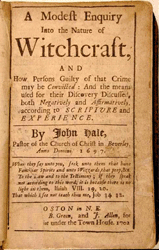Risher ENGL 227 Project
ashleighr09
405
In examining the literature and art of a given time period, one can follow certain trends in a culture. This study examines the public view on witchcraft and the occult, beginning with the shamans of a precivilization America and going until present day.
|
Before the arrival of Europeans in North America, the Natives had a variety of religions, many of which involved a occult practitioner known as a shaman. The annotated bibliography details the research of many individuals into the roles shamans played. Shamans were not only accepted by these early Americans, they were viewed as a necessary part of everyday life. Shamans were relied upon to secure the wellbeing of the tribe, whether by providing, healing, or warding off evil.
|
|
This work touches on the British witch hysteria that preceded the well-known Salem Witch trials. The British prosecution of witches went on for hundreds of years, ending just before the American prosecution began. This suggests that the American fear and hatred of witch was carried over from Britain during colonization.
|
|
This pamphlet, written by John Hale in 1697, is an example of the witchcraft hysteria that descended upon the American public. The front page shows of the rumors surrounded witches. It was widely believed amongst terrified Puritans that these "witches" had familiars that could do their bidding and that they spied on their neighbors. This pamphlet prompts citizens to search out witches and bring them before trial.
|
|
One of the best known witch hunts of colonial America, the Salem witch trials, is seen depicted in this painting. The girl writhing on the floor was one of many girls who accused their neighbors of being witches, claiming they were tormented. The accused were often women who were widowed or single or women who owned large amounts of property, although men were also convicted. As seen in the image, the townspeople cried out against witches, demanding their capture, and the clergy and lawmen were happy to oblige.
|
|
In this work, Richards discusses the culture of 18th century America. In his discussion of the religion of the time, he notes that while Christianity was the prevailing religion of the day, "...belief in folk wisdom or erudite supernaturalism was far more prevalent than has been granted. (pg 580)." Despite this fact, he also notes that 18th century American, though divided among many denominations, was incredibly pious and strove to adhere to religious standards.
|
|
Orians discusses the prevalence of the witchcraft hysteria of the 18th century in literature, which began in 1817. This marks a change in public perception. Rather than viewing witches with fear as did their forefathers, Americans became fascinated with the incidents. This implies a decreasing belief in witchcraft and a shift in the character of the witch from the real life terror to a fictional villain, or even victim.
|
The American view of witches have transformed much throughout history, going from revered to feared then to fictionalized. Through studying the literature of given times, the perception of witches is consistent with climate of the culture. In the mystical time of the Native Americans, witches were the center of society, while they had no place in the rigid Puritan times. This is reflected in the literature of the given time period.






